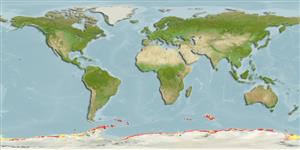Elasmobranchii (tubarões e raias) (sharks and rays) >
Rajiformes (Skates and rays) >
Arhynchobatidae (Softnose skates)
Etymology: Bathyraja: Greek, bathys = deep + Latin, raja, -ae = a ray (Raja sp) (Ref. 45335).
Eponymy: Reverend Alfred Edmund Eaton (1845–1929) was an English explorer, entomologist and naturalist who published many scientific papers (1860s–1920). [...] (Ref. 128868), visit book page.
More on author: Günther.
Issue
The large sequence divergences among B. eatonii from the Kerguelen Plateau and from the South Atlantic-Ross Sea provide evidence for two species in these regions. The species, referred to as Bathyraja sp. (cf. eatonii) from the Antarctic continental shelf and slope is a species distinct from B. eatonii. from the Kerguelen Plateau (the type locality) and thus is a new and undescribed species until it is formally described and named (Ref. 93260).
Environment: milieu / climate zone / depth range / distribution range
Ecologia
marinhas demersal. Polar; 48°S - 78°S, 180°W - 180°E
Southern Ocean: common on the Kerguelen Plateau, around South Orkney and South Shetland islands. In the Antarctic Peninsula, it occurs in the northeastern Weddell Sea and on Gunnerus Ridge. A single record comes from the Pacific Ocean sector, in the Ross Sea. Southeast Pacific: Chile (Ref. 9068).
Tamanho / Peso / Idade
Maturity: Lm ? range ? - ? cm
Max length : 100.0 cm TL macho/indeterminado; (Ref. )
Oviparous (Ref. 50449). Eggs have horn-like projections on the shell (Ref. 205).
Ciclo de vida ou comportamento de acasalamento
Maturidade | Reprodução | Desova | Ovos | Fecundidade | Larvas
Oviparous, paired eggs are laid. Embryos feed solely on yolk (Ref. 50449). Eggs have horn-like projections on the shell (Ref. 205).
McEachran, J.D. and K.A. Dunn, 1998. Phylogenetic analysis of skates, a morphologically conservative clade of elasmobranchs (Chondrichthyes: Rajidae). Copeia 1998(2):271-290. (Ref. 27314)
Status na Lista Vermelha da UICN (Ref. 130435: Version 2024-2)
Ameaça para os humanos
Harmless
Uso pelos humanos
Pescarias: espécies comerciais
Ferramentas
Relatórios especiais
Baixar XML
Fontes da internet
Estimates based on models
Preferred temperature (Ref.
123201): -1.8 - 2, mean -0.9 °C (based on 119 cells).
Índice de diversidade filogenética (Ref.
82804): PD
50 = 0.5000 [Uniqueness, from 0.5 = low to 2.0 = high].
Bayesian length-weight: a=0.00550 (0.00291 - 0.01038), b=3.13 (2.97 - 3.29), in cm total length, based on LWR estimates for this Genus-body shape (Ref.
93245).
Nível Trófico (Ref.
69278): 4.0 ±0.7 se; based on size and trophs of closest relatives
Resiliência (Ref.
120179): Baixo, tempo mínimo de duplicação da população 4,5 - 14 anos (Fec assumed to be <100).
Fishing Vulnerability (Ref.
59153): High vulnerability (60 of 100).
Climate Vulnerability (Ref.
125649): High to very high vulnerability (71 of 100).
Nutrients (Ref.
124155): Calcium = 3.36 [0.52, 69.22] mg/100g; Iron = 0.296 [0.028, 3.977] mg/100g; Protein = 14.2 [12.5, 16.1] %; Omega3 = 0.411 [0.155, 1.082] g/100g; Selenium = 16.7 [3.0, 76.3] μg/100g; VitaminA = 8.07 [0.55, 107.21] μg/100g; Zinc = 0.232 [0.015, 2.709] mg/100g (wet weight);
